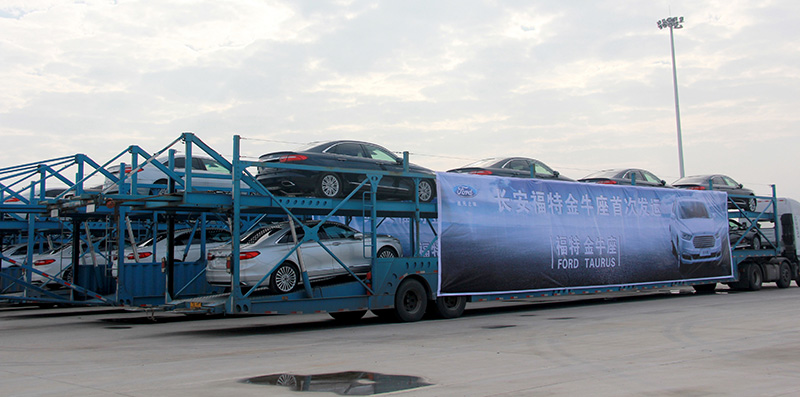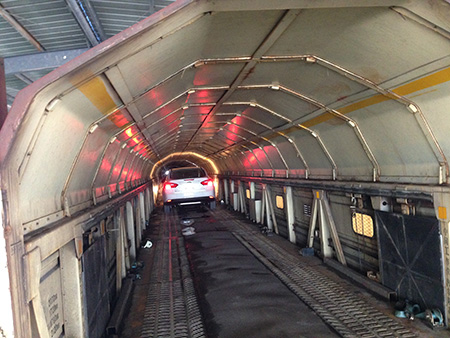 With new regulations leading to price rises and capacity shortages in road transport, Changan Ford is seeking rail and water alternatives where it can, as well as investment by its 3PL
With new regulations leading to price rises and capacity shortages in road transport, Changan Ford is seeking rail and water alternatives where it can, as well as investment by its 3PL
The recent breakaway growth of vehicle production and sales in China – which accelerated in 2016 and has continued into the early months of 2017 – has caused more headaches than usual for some carmakers’ finished vehicle logistics. The rise, propelled in part by a tax reduction on small engines together with a surge in demand for SUVs, has coincided with new regulations governing road vehicle transporters.
In this story...
While the goal of these regulations is to improve levels of standardisation and safety – objectives that many OEMs and providers in the country support – they are also raising prices and affecting delivery times.
Among those carmakers trying to keep up with demand amidst a vehicle logistics market in plain transition is Changan Ford, Ford’s main joint venture in China. The carmaker sold 957,499 vehicles in 2016, an increase of 14% compared to 2015, in line with growth in the overall Chinese market.
Lizzie Xiang, manager of the material planning and logistics (MP&L) vehicle distribution team at Changan Ford, says the new regulations have led to a transport capacity shortage, especially in the first months following their implementation last September. She observes that all OEMs in China were facing the same situation of not having enough trailers to transport finished vehicles, with many since in strong competition to obtain more truck space.
“Since the new regulations were enacted, Changan Ford has been experiencing a huge shortage of car carriers as well as qualified drivers because of the lower loading volume per trailer. We believe that the road transportation capacity shortage will exist for a long time and will result in cost increases,” she says.
Changan Ford has some advantages compared to other carmakers. While its production and distribution network has evolved considerably over recent years, the carmaker has long been a substantial user of inland waterway transport from its main base in Chongqing, in south-west China, using the Yangtze River to move many vehicles east. While road has remained its largest mode of transport, it has been able to buffer its distribution with multimodal flows.
More recently, however, the carmaker has added new production plants elsewhere in China, even as its volume out of Chongqing has also grown substantially. Having multi-point production has increased the potential for more return loads and optimised routings, but has also increased demand for truck capacity overall.
 "Since the new regulations were enacted, Changan Ford has been experiencing a huge shortage of car carriers as well as qualified drivers because of the lower loading volume per trailer. We believe that the road transportation capacity shortage will exist for a long time and will result in cost increases." - Lizzie Xiang, Changan Ford
"Since the new regulations were enacted, Changan Ford has been experiencing a huge shortage of car carriers as well as qualified drivers because of the lower loading volume per trailer. We believe that the road transportation capacity shortage will exist for a long time and will result in cost increases." - Lizzie Xiang, Changan Ford
[sta_anchor id="1"]Now, with the new trucking regulations coming into place, Changan Ford has felt the crunch, with a reduction in available space and a rise in costs. To compensate, Xiang says the carmaker is studying ways to acquire new capacity, including through buying more equipment together with its third party logistics provider, as well as by routing more vehicles via rail.
A multi-point networkChongqing remains Changan Ford’s busiest hub. It is the country’s third largest metropolitan area after Guangzhou and Shanghai, with a population of more than 30m people in the greater area. The joint venture’s first vehicle assembly plant, which opened in 2004, produces the Ford EcoSport compact SUV, the Ford Focus compact car, and the Ford Mondeo mid-size car. Its second vehicle assembly plant, also located in Chongqing, opened in 2012, is almost ten times the area of the original plant and produces the Ford Focus and the Ford Kuga compact SUV. These two plants offer an annual production capacity of 600,000 units.
Changan Ford’s third plant in Chongqing opened in 2014 to produce the Ford Escort, with an annual capacity of 360,000 units.
While Ford’s other joint ventures in China have produced outside Chongqing, including its commercial vehicle plants with JMC in Nanchang and Taiyuan, as well as another joint venture in Taiwan, in the last few years Changan Ford has expanded its regional presence in China. In 2015, it opened a plant in Hangzhou, 200km south of Shanghai, which produces a version of the Ford Edge, a mid-size crossover vehicle, designed exclusively for the Chinese market; Hangzhou has an annual capacity of 250,000 units.
Changan Ford’s fifth and most recent assembly plant is in Harbin, which opened in 2016 in the remote north-east province of Heilongjiang; the plant produces the Ford Focus.
This expanded network has implications, given the trucking changes. According to Xiang, capacity for moving vehicles along the Yangtze and other waterways has limits, although logistics providers are investing in shipping equipment. What she hopes to grow more is the mass movement of vehicles in China by rail, which she sees as having the potential to improve cost and quality for the carmaker’s distribution.
“Since Changan Ford’s primary manufacturing base is located in Chongqing, an inland city, there is a limit to increasing the water transportation proportion. Furthermore, it is more difficult to improve water transportation than rail transportation because the general quantity of ro-ro ships is much less than that of rail containers,” she says.
[sta_anchor id="2"]Xiang observes that OEMs are generally working with carriers and providers to encourage them to purchase more water and railway transport resources because of the road capacity shortage; an increase in multimodal assets will also help to relieve pressure on prices for these modes, which have also started to rise, she says.
Doubling capacity losses But while the carmaker is pursuing multimodal options, it must also manage changes in its finished vehicle distribution road network, as road will remain its most significant mode.
One of the changes that Changan Ford is dealing with is the elimination of double-row trailers to move vehicles, equipment that is being phased out under the new regulations because of safety issues. The average payload of double-row trailers was 20-23 units.
In the past, the government has imposed fines on such trailers, but has not forbidden their usage outright. The new regulations now prohibit overloads in road transport, however, while the allowed load quantity is 10-12 units per trailer with a single row in the upper deck.
Changan Ford is feeling this cut. Although the new rules allow for some lengthening of car carriers, this does little to make up for the lost capacity from double rows. “The new regulations extended the length from 16.5 metres to 18.1 metres, which does not increase the loading volume per car carrier,” says Xiang.
Xiang points out that the regulation changes have led to steep price rises for road haulage. Changan Ford is responding by estimating a plan for expected price increases, and then trying to mitigate those rises by switching flows, where possible, including onto railway and water transport.
The regulations have also influenced how Changan Ford works with its dedicated third party logistics provider, Changan Minsheng APL Logistics, a joint venture between Changan’s logistics arm and APL Logistics. For example, while Changan Ford sets the standard load basis for its vehicle logistics, in most cases it is the 3PL or occasionally common carriers that do the actual load planning and execution. The carmaker therefore had to quickly adjust its load standards – decreasing the amount of vehicles per transport – to avoid estimating or paying for bigger loads than it actually receives. However, although the new standard is in place, Xiang acknowledges that actual amount of vehicles per truck varies based on Changan Minsheng APLL’s operations.
The carmaker has also recognised that Changan Minsheng APLL needs to introduce new carriers and carrier subcontractors into its system to reduce the capacity shortage. “We requested our 3PL to acquire more road transportation capacity in reaction to the shortage issue caused by the new carrier regulations. This includes investing in new carriers,” she explains.

Together with its 3PL, Changan Ford has considered whether it would be best to bring in new contract carriers to provide vehicle transport services, or for Changan Minsheng APLL Logistics to purchase more trailers itself and operate them. “In fact, we prefer the latter method, because it is easier for our 3PL to control the trailers and the risk is lower since there are fewer intermediaries involved,” she says.
[sta_anchor id="3"]Xiang also wants to ensure that any new contracted carriers have the resources to handle services as well as to respond to growth as necessary. “A single carrier’s capacity is static, which could be a risk to the long-term operation,” she says.
The centre must holdAmong the new transporter designs that comply with GB1589 are centre-axle car carriers, which are being introduced in China. The set dimensions will be 22 metres in length, with a limit of 12 metres on the trailer, 2.6 metres width, and 4 metres height. The centre-axle vehicles will thus be longer and able to carry larger loads than semi-trailer combinations, which will have a standard maximum length of 18.1 metres.
For Changan Ford, the average load volume will increase from six vehicles per semi-trailer to eight or nine vehicles per centre-axle vehicle. Secondly, centre-axle trailers are deemed safer than semi-trailers because of their decreased turning radius, which helps to reduce the risk of damage. Xiang estimates that centre-axle trailers will improve efficiency and penalties will be less once the government approves more types of equipment for service in China.
There are currently, however, very few centre-axle trailer manufacturers in China, and production capacity appears set to fall far short of demand, which will also affect prices and transport capacity investment. Because of the supply shortage, it also tends to be difficult to recruit and manage drivers who are qualified to drive the new equipment.
While centre-axle trailers are supposed to be safer – they are more common in western countries – there is almost no operational experience or cost data on these types of transporters in China. “This means it is difficult for our 3PL and common carriers to choose between semi-trailers and centre-axle trailers,” says Xiang.
She also identifies capital and investment constraints at providers. “Rather than rolling out centre-axle trailers to the market significantly, many 3PLs and common carriers would seem to rather hoard cash, which has affected investment in new transportation capabilities,” she says.
Other manufacturers and logistics providers have indicated – and Lizzie Xiang agrees with them – that the execution of the new regulations varies by region and province in China, which can result in difficulties and confusion on the road. Xiang says that because of this, Changan Ford needs to shift to other transport modes or change routes.
 A disparity in load limits between different parts of the country has led Changan Ford to adjust its advanced planning system and seek more efficient alternatives
A disparity in load limits between different parts of the country has led Changan Ford to adjust its advanced planning system and seek more efficient alternativesFor example, the new regulations issued by the central government allow all trailers of different lengths to use the road as long as they are registered and there is only a single row loaded in the upper deck (this will change in the second phase of the regulation in July next year). However, in southern province of Hunan, for example, the traffic department is very strict regarding trailer length and only six units per loaded trailer have been allowed since last year.
[sta_anchor id="4"]Furthermore, in some northern areas of the country, no more than 12 loaded units are allowed, while in some western areas this can be as many as 14. The result is significant disparity in permitted payloads, depending on the region or province. As a means of minimising such disparity, Changan Ford is adjusting its transport network’s advanced planning system and increasing the use of large-scale rail transport where feasible, but there are limits to current rail services.
A chance to start againAlthough the adjustment is painful and costly, Xiang also sees such changes as opportunities to modernise operations in the vehicle road carrier market and to improve efficiency.
“The industry’s road transport capacity had been inadequate for some time because the actual execution of truck standards was different from the government’s information,” Xiang explains.
“In fact, many carriers had ceased operations due to the differences in the execution of standards in different areas.”
Changan Ford is facing new car carrier regulations by trying to secure adequate road transport capacity in the most cost-effective way possible through its 3PL’s capabilities and investments, as well as its own network planning. It is also focusing on other transport modes as a complement to road carriers. Although there is a significant adjustment necessary to comply with the new car carrier regulations, there are also opportunities to improve finished vehicle logistics efficiency in China’s fast-changing vehicle logistics market.





































